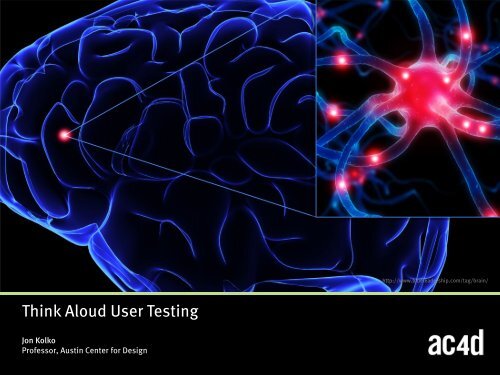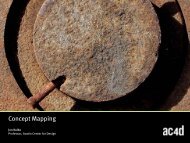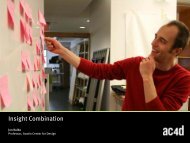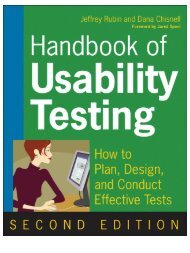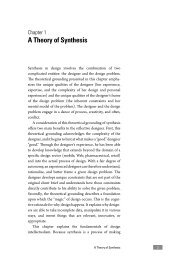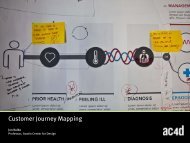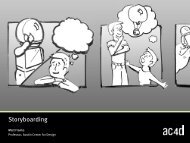Think Aloud User Testing - Austin Center for Design
Think Aloud User Testing - Austin Center for Design
Think Aloud User Testing - Austin Center for Design
Create successful ePaper yourself
Turn your PDF publications into a flip-book with our unique Google optimized e-Paper software.
http://www.blueleadership.com/tag/brain/<br />
<strong>Think</strong> <strong>Aloud</strong> <strong>User</strong> <strong>Testing</strong><br />
Jon Kolko<br />
Professor, <strong>Austin</strong> <strong>Center</strong> <strong>for</strong> <strong>Design</strong>
<strong>Think</strong> <strong>Aloud</strong> <strong>Testing</strong><br />
Evaluating the usability of your work by<br />
encouraging a user to think out loud as<br />
they use your product or service.
<strong>Think</strong> <strong>Aloud</strong> <strong>Testing</strong><br />
Evaluating the usability of your work by<br />
encouraging a user to think out loud as<br />
they use your product or service.
<strong>Think</strong> <strong>Aloud</strong> <strong>Testing</strong><br />
Evaluating the usability of your work by<br />
encouraging a user to think out loud as<br />
they use your product or service.
<strong>Think</strong> <strong>Aloud</strong> <strong>Testing</strong><br />
Evaluating the usability of your work by<br />
encouraging a user to think out loud as<br />
they use your product or service.
<strong>Think</strong> <strong>Aloud</strong> <strong>Testing</strong><br />
Evaluating the usability of your work by<br />
encouraging a user to think out loud as<br />
they use your product or service.<br />
THINK ALOUD TESTING/<br />
1. Is evaluative, in that it responds to an existing artifact<br />
2. Identifies defects that impact comprehension<br />
3. Is considered a “quick and dirty” method, as compared to a <strong>for</strong>mal experiment<br />
4. Requires interacting with real people
Background: Understanding Memory<br />
Working Memory<br />
Central Executive<br />
(Supervision)<br />
Phonological Loop<br />
(Sounds of language – repetition)<br />
Episodic Buffer<br />
(Experiential qualities)<br />
Visuo-Spatial Sketchpad<br />
(Imagery, spaces, environments,<br />
mental maps)<br />
Long Term Memory Store<br />
7
Background: Understanding Memory<br />
Working Memory<br />
Limited capacity<br />
Fast decay time<br />
Generally, driven by attention<br />
Long Term Memory Store<br />
“Unlimited” capacity<br />
Slow decay time<br />
Generally, driven by associations and relationships<br />
8
Background: Allen Newell & Herb Simon<br />
• Founders of artificial intelligence,<br />
decision making, bounded<br />
rationality.<br />
• 1972: Newell & Simon wanted to<br />
understand how people solve<br />
problems; needed to understand<br />
the sequence of thoughts people<br />
experience as they work through a<br />
problem.<br />
• Ultimate goal was to simulate<br />
human problem solving with<br />
Artificial Intelligence.<br />
9
Background: Why it Works<br />
• Developed experiments where one set of participants “verbalized their thoughts<br />
as they went about a task” and the other set did not.<br />
• Found that there is no affect on thought sequences, as long as there is no<br />
introspection:<br />
• People can successfully verbalize what they are doing without changing the<br />
outcome of a task.<br />
10
Background: Why it Works<br />
Specifically, people can verbalize<br />
the contents of working memory.<br />
Working Memory<br />
Limited capacity<br />
Fast decay time<br />
Generally, driven by attention<br />
Long Term Memory Store<br />
“Unlimited” capacity<br />
Slow decay time<br />
Generally, driven by associations and relationships<br />
11
Background: Why it Works<br />
• When the in<strong>for</strong>mation is not linguistic (ie, when it is visual), this will slow down the<br />
task, but will not alter the validity of the task.<br />
• If there is introspection (“why am I doing this?” or “what am I thinking about?”),<br />
the outcome changes.<br />
• This is <strong>for</strong>mally called the <strong>Think</strong> <strong>Aloud</strong> Protocol (a Protocol is a standard procedure<br />
<strong>for</strong> regulating data transmission – in this case, the tasks a person is completing): a<br />
way of understanding what someone is doing, as they do it.<br />
• Or, put another way, this is a way of understanding the contents of working<br />
memory.<br />
12
Planning a <strong>Think</strong>-<strong>Aloud</strong> <strong>User</strong> <strong>Testing</strong> Session<br />
1. Develop a prototype.<br />
You’ll need all of the screens that a user will see completed, but they don’t need to<br />
be working – you can do <strong>Think</strong> <strong>Aloud</strong> <strong>Testing</strong> with paper.<br />
13
Planning a <strong>Think</strong>-<strong>Aloud</strong> <strong>User</strong> <strong>Testing</strong> Session<br />
2. Develop tasks that represent typical user goals.<br />
Our scenarios are a great place to start.<br />
There must be a complete path through the interface to solve these goals (don’t<br />
give the user impossible tasks, it’s mean).<br />
Print these tasks, one to a page.<br />
14
Planning a <strong>Think</strong>-<strong>Aloud</strong> <strong>User</strong> <strong>Testing</strong> Session<br />
3. Schedule sessions with users that match the target audience<br />
2-8 users, one per session<br />
15
Planning a <strong>Think</strong>-<strong>Aloud</strong> <strong>User</strong> <strong>Testing</strong> Session<br />
4. Organize yourself<br />
Video camera, batteries, audio camera, tapes, pens, etc.<br />
16
<strong>Think</strong> <strong>Aloud</strong> – How Many <strong>User</strong>s?<br />
Lowest Percentage of Usability Problems Found<br />
25% 50% 75% 100%<br />
Diminishing Returns<br />
Source: Beyond the five-user<br />
assumption: Benefits of<br />
increased sample sizes in<br />
usability testing. By Laura<br />
Faulkner, University of Texas,<br />
<strong>Austin</strong>, Texas. In Behavior<br />
Research Methods,<br />
Instruments, & Computers.<br />
2003, 35 (3), 379-383<br />
1 2 3 4 5 6 7 8 9 10 11 12 13 14 15 16<br />
Number of <strong>User</strong>s<br />
17 18 19 20 21 22 23<br />
17
Running a <strong>Think</strong>-<strong>Aloud</strong> <strong>User</strong> <strong>Testing</strong> Session<br />
5. Get set up.<br />
Prepare the physical arrangement.<br />
Get written consent to tape.<br />
Don’t <strong>for</strong>get to start taping!<br />
Test participant<br />
18
Running a <strong>Think</strong>-<strong>Aloud</strong> <strong>User</strong> <strong>Testing</strong> Session<br />
6. Explain the rules.<br />
Explain to the user:<br />
• who you are & what you are doing<br />
• that you are testing your interface, and not testing them<br />
• that they can quit at any time<br />
• that you won’t be able to help them<br />
• that you require them to continue talking, and you will remind them to “please<br />
keep talking” if they fall silent<br />
• To simply verbalize what it is they are doing, as they are doing it<br />
Verify that the user understands the tasks (have them read the tasks aloud too,<br />
and ask if there are any questions)<br />
19
Running a <strong>Think</strong>-<strong>Aloud</strong> <strong>User</strong> <strong>Testing</strong> Session<br />
7. Run the session.<br />
Take good notes!<br />
If the user falls silent <strong>for</strong> more than three seconds, prompt them “please keep<br />
talking”<br />
Do not help the user complete a task (if the user asks <strong>for</strong> help, explain that you<br />
cannot help, and prompt them to try what they think is correct)<br />
Don’t defend your designs! This is not a critique of your design skills; don’t even<br />
mention that they are your designs.<br />
Be thoughtful – these are real people!<br />
20
Running a <strong>Think</strong>-<strong>Aloud</strong> <strong>User</strong> <strong>Testing</strong> Session<br />
7. Run the session, continued.<br />
While the session is running, do not say things like:<br />
Please explain what you are doing<br />
Note any design problems you see<br />
Tell us if you have any suggestions<br />
Why are you doing what you are doing<br />
By asking questions like this, we call into play Mediated Processes, such as<br />
cognitive processes, which can disrupt the in<strong>for</strong>mation state and alter the data.<br />
Specifically – we lose track of what was in working memory, and replace it with<br />
something else.<br />
21
After a <strong>Think</strong>-<strong>Aloud</strong> <strong>User</strong> <strong>Testing</strong> Session<br />
8. Identify Critical Incidents<br />
Determine the critical incidents that occurred:<br />
To be critical, an incident must occur in a situation where the purpose or intent of the act seems fairly<br />
clear to the observer and where its consequences are sufficiently definite to leave little doubt concerning<br />
its effects (p. 327).<br />
Such incidents are defined as extreme behavior, either outstandingly effective or ineffective with respect<br />
to attaining the general aims of the activity (p. 338).<br />
Flanagan, (1954), Psychological Bulletin, 51 (4), 327-358.<br />
22
After a <strong>Think</strong>-<strong>Aloud</strong> <strong>User</strong> <strong>Testing</strong> Session<br />
8. Identify Critical Incidents, continued<br />
Some (not all) criteria <strong>for</strong> identifying a Bad Critical Incident:<br />
The user articulates a goal and cannot succeed in attaining that goal within two minutes<br />
The user articulates a goal, tries several things and explicitly gives up<br />
The user articulated a goal and has to try three or more things be<strong>for</strong>e finding a solution<br />
The user does not succeed in the task<br />
The user expresses surprise<br />
The user expresses some negative sentiment, either about the interface or about their own skills<br />
The user makes a design decision<br />
23
After a <strong>Think</strong>-<strong>Aloud</strong> <strong>User</strong> <strong>Testing</strong> Session<br />
9. Calculate a SUS score per user<br />
Strongly<br />
Disagree<br />
Strongly<br />
Agree<br />
I think that I would like to use this system frequently.<br />
1 2 3 4 5<br />
I found the system unnecessarily complex.<br />
I thought the system was easy to use.<br />
I think that I would need the support of a technical person to be able to use this system.<br />
I found the various functions in this system were well integrated.<br />
I thought there was too much inconsistency in this system.<br />
I would imagine that most people would learn to use this system very quickly.<br />
I found the system very cumbersome to use.<br />
I felt very confident using the system.<br />
I needed to learn a lot of things be<strong>for</strong>e I could get going with this system.<br />
24
After a <strong>Think</strong>-<strong>Aloud</strong> <strong>User</strong> <strong>Testing</strong> Session<br />
10. Calculate an average SUS score <strong>for</strong> all users.<br />
For odd items: subtract one from the user response.<br />
For even-numbered items: subtract the user responses from 5.<br />
This scales all values from 0 to 4 (with four being the most positive response).<br />
Add up the converted responses <strong>for</strong> each user and multiply that total by 2.5. This<br />
converts the range of possible values from 0 to 100 instead of from 0 to 40.<br />
Average across all users.<br />
25
Presenting <strong>Think</strong>-<strong>Aloud</strong> <strong>Testing</strong> Findings<br />
You might be presenting Usability findings…<br />
• To propose design decisions<br />
• To defend or rationalize design decisions<br />
• To educate a naïve development or business team<br />
• To evangelize to a skeptical development or business team<br />
26
Presenting <strong>Think</strong>-<strong>Aloud</strong> <strong>Testing</strong> Findings<br />
Generally, your audience wants to know…<br />
• What is the problem?<br />
• How was the problem identified – was your methodology sound?<br />
• How are you sure that it’s a problem – what evidence do you have?<br />
• How important is it to fix the problem, relative to other problems?<br />
• What are the technical and business implications of solving (or not solving) the<br />
problem?<br />
27
Presenting <strong>Think</strong>-<strong>Aloud</strong> <strong>Testing</strong> Findings<br />
What method was used?<br />
Explain how think aloud works<br />
Explain why think aloud works<br />
Explain how many people you spoke with, and why such a small sample is acceptable<br />
28
Presenting <strong>Think</strong>-<strong>Aloud</strong> <strong>Testing</strong> Findings<br />
What are the top 3 problems?<br />
Show a screen shot<br />
Circle the problem area in a big red box<br />
Include an actual quote from a user<br />
Propose a recommendation fix<br />
29
<strong>Think</strong> <strong>Aloud</strong> <strong>Testing</strong> – Recap<br />
Evaluating the usability of your work by<br />
encouraging a user to think out loud as<br />
they use your product or service.<br />
THINK ALOUD TESTING/<br />
1. Is evaluative, in that it responds to an<br />
existing artifact<br />
2. Identifies defects that impact<br />
comprehension<br />
3. Is considered a “quick and dirty” method,<br />
as compared to a <strong>for</strong>mal experiment<br />
4. Requires interacting with real people<br />
RUNNING A THINK ALOUD TEST/<br />
1. Develop a prototype.<br />
2. Develop tasks that represent typical user goals.<br />
3. Schedule sessions with users that match the<br />
target audience<br />
4. Organize yourself<br />
5. Get set up.<br />
6. Explain the rules.<br />
7. Run the session.<br />
8. Identify Critical Incidents.<br />
9. Calculate a SUS score per user.<br />
10. Calculate an average SUS score <strong>for</strong> all users.
Let’s try it..
Jon Kolko<br />
Director, <strong>Austin</strong> <strong>Center</strong> <strong>for</strong> <strong>Design</strong><br />
jkolko@ac4d.com<br />
Download our free book,<br />
Wicked Problems: Problems Worth Solving,<br />
at http://www.wickedproblems.com


